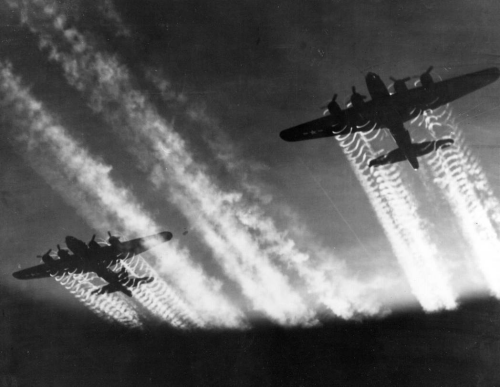
Dean Satterlee in B-17 Flying Fortress

Dean Satterlee in B-17 Flying Fortress
Dean Satterlee was transferred to Moose Jaw, SASK. while still in the Royal Air
Force as an instructor. In fact, much of the time spent while on active flight
status in the RAF was as a flight instructor, according to his flight logs. This
was a secondary duty to flying combat missions, but it sure increased his flight
hours. Mardelle joined him in Moose Jaw, and I am sure was very appreciative to
have Dean come home every night. This tour was in reality the honeymoon they never
had.
Click here for a newspaper
clipping about Dean's final tour in the RAF.
Dean was given the opportunity while in Moose Jaw to transfer to the US Army Air
Corps, since, after Pearl Harbor, America had entered the war. Combat pilots were
highly sought after, and all the Eagle Squadron pilots were given the same option.
Quite a few, including Dean, took advantage of the offer, although many chose to
continue to fly in the RAF.
After resigning his RAF commission, Dean Satterlee was given 1st Liutenant bars and
transferred to Arizona to continue his work as a combat flight instructor. Mardelle
followed him to Tempe. I don't know too much about that period except some stories
about scorpions Mom told me. Apparently this was base housing, and bug control was
provided by the occupant.
One of the reasons Dean liked instructor duty was that he had company while flying.
Perhaps this was a factor when Dean became a student rather than an instructor in
multi-engine heavy aircraft. Life expectancy was even lower in bomber service than
in fighter service, but that notwithstanding, Dean readily admitted that multi-engine
was more to his liking.
Dean Satterlee returned to England, this time as a USAAF pilot of a B-17. Quite a
step from Spitfires and Hurricanes, and it is likely he knew first hand some of his
RAF fighter escorts while on missions. This was a different kind of war. It was no
longer you against the pilot in the enemy aircraft, this was a punch in the nose to
Nazi Germany and it's industrial war machine. A huge number of missions that Dean
flew in his B-17, nicknamed the 'Bad Penny' (a bad penny always comes back, so
the saying goes), were rail targets. This tactic was intended to disrupt transportation
of everything from food, fuel, war materials, and enemy troop movements. Reading
Dean's flight logs of his B-17 missions is just as facinating as his RAF logs. It
is easier, however, to relate to bombing missions and ground targets than fighter
operations.
25 bomber missions was the ticket home. That seems like a low number until reminded
that life expectancy, especially in the early period of perfecting daylight bombing,
was 3 to 4 missions. Some unlucky crews never returned from their first raid. Perhaps
the 'Bad Penny' name kept Dean and his crew alive. After reaching his 25 mission
plateau, Dean Satterlee was given some needed R&R. He had already made up his mind
that he would volunteer for another tour, and he got his wish.
There was no shortage of volunteers to fly with Dean Satterlee. The 'Bad Penny' always
came back. Superstition in war is raised to almost a religion. Dean understood combat
air tactics, was always teaching his crew what to expect and how to deal with enemy
attacks, and was a gifted pilot. He demanded, and got, bombs on target. In his eyes,
a miss meant comming back tomorrow through fighters and flak to do it again.
Click here for a newspaper
clipping about Dean Satterlee as pilot of the B-17 'Bad Penny'.
The 'Bad Penny' still kept coming back. The bombing campaign was showing a success
in the war effort. D-Day was still a while away, but the bombers kept pounding
Germany.
Click here for newspaper
clipping showing Dean and one of the 'Bad Penny' gunners.
The 'Bad Penny' had it's share of bad luck too. Just not fatal. Dean told me that in
all his flying career, from RAF fighters, to B-17, to C-47 and C-54 cargo operation
after the war he had never lost an engine. That is remarkable. In combat, it is mostly
luck, but a good mechanic doesn't hurt either.
Click here for a newspaper
clipping describing an incident aboard the 'Bad Penny' aircraft. Nor is it proper to
imply that there were no crew injuries under Dean Satterlee's command. I do know that
he never personally received a Purple Heart award, but almost everything else.
Aircraft were not always available for a particular mission because of maintenance due to battle damage, engine servicing, or other causes. Likewise, air crews were not always available because of illness, R&R leave, etc. Dean flew a mission on the aircraft Swamp Fire, a historic B-17G at Kimbolton, on Mission Number: 91 for the 379th flown on 3/28/1944 against Dijon / Longvic , France. See the Swamp Fire site for more on this aircraft and her crews.
Dean flew his final B-17 mission on 25 October 1944.
Click here for a list of missions flown by Dean Satterlee, derived from the book "Shades
of Kimbolton (copy #627)" which was annotated by Dean in the mid 1980s.
For more information on B-17 operations at Kimbolton, see the
RAF Kimbolton article.
This Page Maintained by: Brian Satterlee,
Last Updated: May 2010